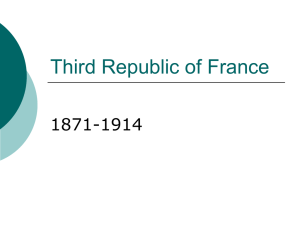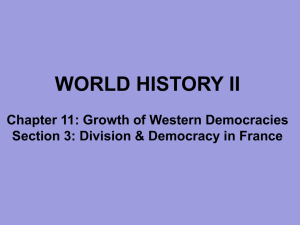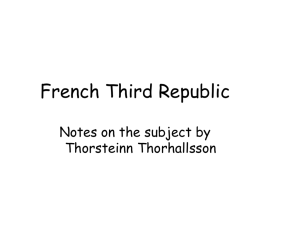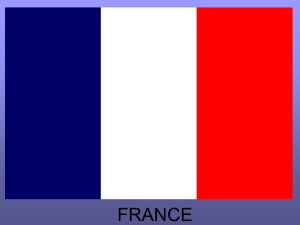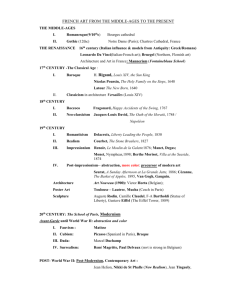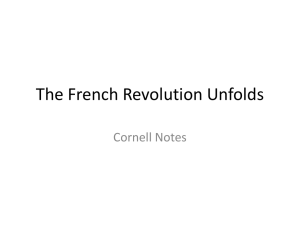La Belle Époque France 1871-1914 McKay 838
advertisement
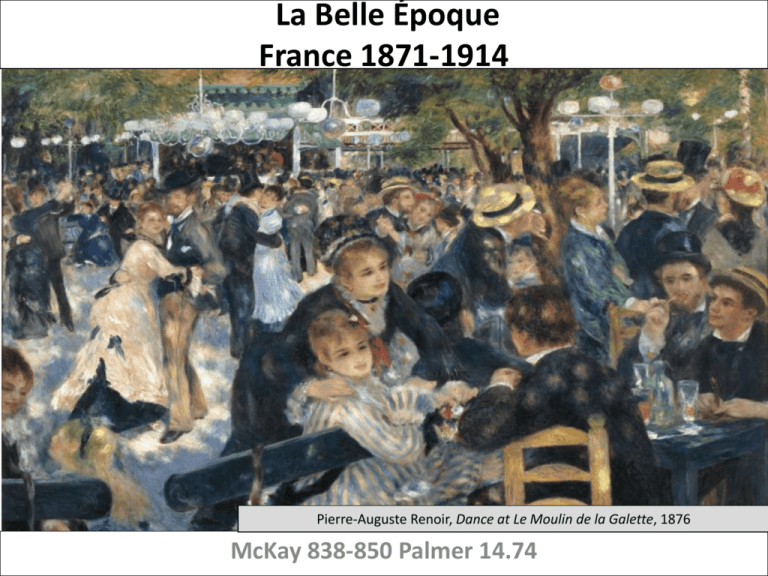
La Belle Époque France 1871-1914 Pierre-Auguste Renoir, Dance at Le Moulin de la Galette, 1876 McKay 838-850 Palmer 14.74 French Third Republic (1870-1940) Napoleon III captured -Republic Proclaimed 1870 Thiers replaced with MacMahon as president 1873 -German Empire Declared -Franco Prussian War ends -Paris Commune (1871) Captain Dreyfus convicted of espionage 1879 MacMahon resigns 1894 Third Republic replaced by Vichy government 1906 Dreyfus case dismissed 1940 La Belle Epoch/Age of Imperialism 1871-1914 • • • • • • • • • period in European history (1871-1914) considered a "golden age" for the upper classes – Overlaps and includes the Victorian/ Edwardian Era, Era of Bismarck, the Gilded Age in America Period of relative peace prevailed, increased leisure time, technological boom, prosperity, ostentation, “New Imperialism, the façade of harmony Gustave Caillebotte, (1848–1894), Champagne perfected, telegraph invented, department store developed, cafes, Paris Street, Rainy Day, 1877 secularism Emergence of mass politics & political parties Birth of spectator sports (soccer, bicycle races, the Olympics (1896) Mass loyalty to nation-state via mass education Growing disparity between haves/have nots distracted via imperial conquests Under surface avant garde (Freud, Nietzsche, Camille Pissarro, Boulevard Montmartre, Einstein) are breaking the paradigm 1897 Art of La Belle Époque Impressionism (1860s-1900) • Meant to capture one’s “impression” of a moment in time • First glance • A reaction to photography – A subjective alternative • Like Barbizon style, subject matter was secular, non-historical – But not realistic – Day to day activities, landscape • visible brush strokes, emphasis on light in its changing qualities Pierre-Auguste Renoir, Dance at Le Moulin de la Galette, 1876 – accentuated the effects of the passage of time – ordinary subject matter • Light colors usually reserved for historic themes • Rejected at 1st by critics • Some pieces were laced with critique of bourgeois society – Edouard Manet’s Barmaid at the FoliesBergere Claude Monet, Impression, soleil levant (Impression, Sunrise), 1872 Pissarro, The garden at Pontoise, painted in 1877 Camille Pissarro, Boulevard Montmartre, 1898 Is she merely serving drinks or sadly something more? Edouard Manet’s A Barmaid at the Folies-Bergère Edoard Manet’s Olympia (1863) Art of La Belle Époque French Academic Style • Synthesis of Neo Classicism and Romanticism • Mythological themes of Classical subjects with a heavy emphasis on the female human body • Secular themes painted from still life • A favorite style among the wealthy bourgeois of La Belle Epoque • Critiques called it sentimental, clichéd, conservative, noninnovative, bourgeois, and "styleless" Return of Spring (1886) This Year Venuses Again… Always Venuses!. Honoré Daumier, No. 2 from series in Le Charivati, 1864 1863 Alexandre Cabanel - The Birth of Venus This Year Venuses Again… Always Venuses!. Honoré Daumier, No. 2 from series in Le Charivati, 1864 Decline of the Second French Empire • Liberalization was designed to divert criticism from Napoleon III’s unsuccessful foreign policy – Crimean War benefited France little – Italian Unification – Establishment of North German Confederation • Franco-Prussian War (18701871) – Napoleon III was lured into a war via the Ems Dispatch – Thought war would return him to glory, power – Second French Empire collapsed after the capture of Napoleon III during the Battle of Sedan Napoleon III with Bismarck after B. of Sedan Characteristics of the Third Republic Politically very unstable Intended to be a temporary republic until a new monarch could be found • Plagued by short lived ministries (political instability) – 50 between 1871-1914 (disruptive to continuity) Extremely polarized Republicans v Monarchists Corrupt, Anti-Semitic & Scandals Ridden The Boulanger Affair The Panama Canal Scandal The Dreyfus Affair [L’Affaire] Still, it survived longer than any other regime since 1789! (1871-1940) Third French Republic Declared! Napoleon III abdicated September, 1870 New government headed by Conservative Adolphe Thiers Reluctantly continued the fight against the Germans who laid siege to Paris To defend Paris, a National Guard was raised numbering over 350,000 France surrendered in February, 1871 after 40,000 Parisians died Prussian troops marched into Paris in March, 1871 – Bismarck called for free elections for members of a National Assembly • Needed a legitimate government to surrender • Third Republic declared The Third French Republic • Elections led to large monarchist presence in the National Assembly (400 out of 600) • Republicans were distrusted by provincial French people • Viewed as violent, stupid in foreign policy, unfriendly to Church, too socialistic • Thiers’ provisional President but viewed as: • Unpatriotic (had opposed war from the start) • Too conservative (supported Falloux Laws) • Too ready to accept a humiliating peace with Prussia (Alsace & Lorraine) • Too Royalist (government established itself at Versailles, NOT in Paris) • Parisians seethed with angered • March 18, 1871 Thiers ordered army to remove cannons from Montmartre • Parisians said NO!!!!!!!!!!!!!!!!! The Montmartre Section of Paris The Paris Commune (March-May, 1871) • Parisians (republicans, socialists, anarchists, Jacobins, workers) declared the Paris Commune • Lasted from March 18-May 28, 1871 • Viewed by Marxists as a communist utopia • Was really a revival of Jacobinism (’93) more than a social revolution • Republicans characterized by patriotic, anti-bourgeois, antiaristocrats/clergy, pro price, wage control, and working condition supervision • But not sweepingly socialist • Dreamed of small direct democratic communes A contemporary sketch of women and children helping take two National Guard cannons to Montmartre Communard Reforms Allowed unions & workers cooperatives to take over factories not in use and start them up again Set up unemployment exchanges in town halls Provide basic elementary education for all were strongly against churchcontrolled schools Day nurseries near factories for working mothers inspiration to later revolutionaries like Vladimir Lenin Paris Commune (March to May 1871) • • • • • • • • May 21 western gate was left opened Known as the “Bloody Week Thiers ordered National Assemblies armies to invade 25,000 Communards killed 38 thousand arrested 330 thou were denounced 7, 500 deported to New Caledonia Third Republic is born amidst class hatred & terror Basilica of the Sacred Heart of Paris Sacré-Cœur • Cathedral built (1875-1914) • Conceived as a national penance for the excesses of the Second Empire and socialist Paris Commune • Built over most rebellious neighborhood • Embodiment of conservative moral order Characteristics of Third Republic Republic meant to be temporary New French legislative assembly dominated by monarchists BUT Divided over which royal family their wished to grant throne Legitimist (Bourbon) supported Henri, Count of Chambord 1st in line to receive crown Descendant of Charles X He refused crown unless given near absolutist power Refused Tricolor Bonapatist- were discredited Orléanists wanted descendant of Louis Phillipe But as time passed French cooled on idea of monarchy The Boulanger Affair General Georges Boulanger- Minister of War Extremely popular general nationalist who was loved by republicans and conservatives in the military Became involved in plot to seize gov. and become dictator Was summoned to trial in 1887 fled to Belgium where he committed suicide on the grave of his mistress Shook confidence in stability of Gov. Panama Canal Scandal : Ferdinand de Lesseps President of the French Company that worked on the Panama Canal Govt. officials took bribes from the company to withhold news from the public that it was in serious economic debt One billion francs affecting 800,000 investors All but one of the accused went unpunished due to lack of evidence Anti-Semitism: Two German Jews were also involved received the most press coverage Results: Scandal proved to the public that the Republic was corrupt It created a climate of anti-Semitism that would increase in time The Dreyfus Affair * * * * * In 1894 a list of French top secret military documents [called a bordereau] were found in the waste basket of the German Embassy in Paris Captain Alfred Dreyfus * Jewish officer accused of spying for Germans Dreyfus was tried, convicted of treason, and sent to Devil’s Island in French Guiana Major Esterhazy * Real culprit whose handwriting was the same as that on the bordereau government tried him and found him not guilty in two days Author, Emile Zola, published an open letter called J’Accuse! accused the army of a mistrial and cover-up govt. prosecuted him for libel Found him guilty sentenced to a year in prison J’Accuse! (1898) But this letter has been long, Mr. President, and it is time to conclude. I accuse Lt-Col du Paty du Clam of having been the diabolical agent of the miscarriage of justice, unconsciously, I want to believe, and of having defended his deed for the past three years by preposterous and extremely guilty machinations. I accuse General Billot of having held in his hands evidence that would have exonerated Dreyfus and of having suppressed it, of having committed this crime against humanity and justice for a political end, and to save the compromised staff. I have but one passion: to enlighten, in the name of humanity that has suffered so much and deserves happiness. My inflamed protest is simply a cry from my soul. Let them dare summon me before a court of law and let the inquiry take place in the light of day! I am waiting. Please accept, Mr. President, the assurance of my most profound respect. Emile Zola The Dreyfus Affair Public opinion was divided it reflected the divisions in Fr. society Dreyfusards were anti-clericals, intellectuals, free masons, & socialists Anti-Dreyfusards, the honor of the army was more important than Dreyfus’ guilt or innocence Were army supporters, monarchists, & Catholics Dreyfus finally got a new trial in 1899. He was brought back from Devil’s Island white-haired and broken. Results: Found guilty again, BUT with extenuating circumstances. Was given a presidential pardon. Exonerated completely in 1906. Served honorably in World War I. Died in 1935 Results of Drefus Affair * * * * * * Army purged of Right-winged Conservatives The Zionist Movement * Led by Theodore Herzl * Was motivated by the Dreyfus trial to write the book, Der Judenstaat, or The Jewish State in 1896 * Creates the First Zionist Congress in Basel, Switzerland * “Father of Modern Zionism.” Ferry Laws Separation of Church and State -Only the State could grant The anti-clerical, republican left took power in degrees. -Free education in public the National Assembly in 1879. primary schools. This anti-Catholicism was a remnant of the -Religious instruction was French Revolution excluded from the State Ferry Laws [1879-1885]: school curriculum. * Named after Jules Ferry, one of the ablest -Unauthorized religious orders forbidden to teach. politicians of the 3rd Republic -State improved training of * first major attempt at educational reform teachers Building the Republic • After 1879 the Third Republic’s Assembly was composed mostly of Republicans • Reforms • Trade unions legalized • Free compulsory elementary schools est. for boys and girls • Critical tool of nation building • Ended Catholic monopoly on education • Learned pledge of allegiance and Marseilles instead of catechism and “Ave Maria” • Bastille Day declared national holiday • Taught by married men and women – Served as vivid contrast to celibate nuns, priests – Easier for married people to cope with loneliness of teaching in villages – Stimulate low birth rate Claude Monet, Rue Montorg ueil, Paris, Festival of 30 June 1878. In France, children were taught in school to not forget the lost provinces of Alsace-Lorraine, which were colored in black on maps 1889 Paris Exposition * World’s Fair held in honor of the French Revolution Centennial. * The Eiffel Tower, completed in 1889, served as the entrance to the Fair. 1889 Paris Exposition: Gallery of Machinery
